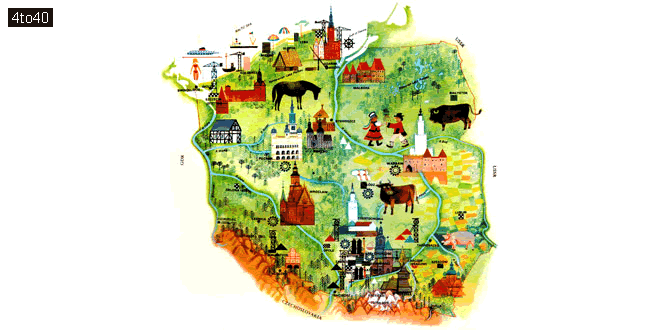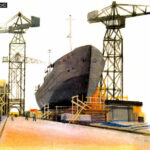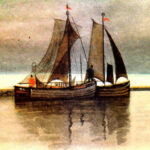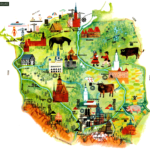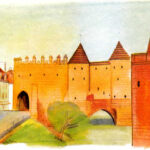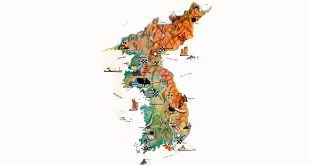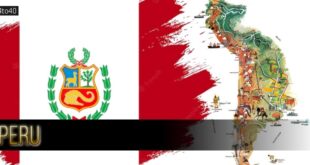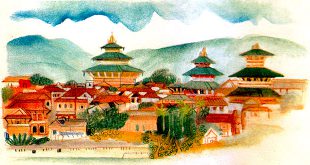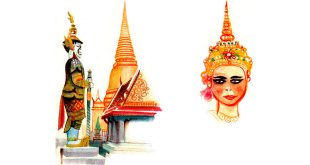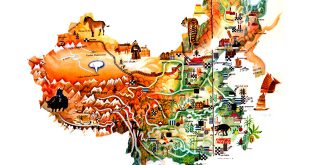Country Name: Poland
System of government: Socialist Republic
Capital: Warsaw (Warszawa)
Location: On the Baltic Sea, Poland shares land frontiers with the German Democratic Republic in the west.
Area: 312, 677 sq km
National composition: Poles from the majority, with German, Ukrainian, Belorussian, Slovak, Russian, Lithuanian, Czech and Gypsy minorities. More than eight million Poles living abroad claim Polish nationality
Religion: Roman Catholic
Official language: Polish
Currency: Złoty =100 groszy
Administrative divisions: Poland is currently divided into 16 provinces known as voivodeships.
Other major cities: Lodz, Cracow (Krakow), Wroclaw, Poznan, Gdansk (Danzig), Szczecin (Stettin)
Highest elevation: Rysy (2,499 m) in the High Tatra Mountains
Chief rivers: Vistula (Wisla), with its tributaries; Order (Odra) with its tributaries
Climate: A transition between the temperature maritime type and the continental type
Anthem: Mazurek Dąbrowskiego
(Dąbrowski’s Mazurka)
Poland Location Map:
Poland Encyclopedia Facts For Students
Plains cover more than a half of Poland. The Baltic coast is characterized by sandy plains with numerous lagoons formed behind sandbars. South of the coastal lowlands are the Pomeranian and Masurian lake districts of the Baltic Lake Plateau, separated by the River Vistula. The two lake districts are dotted with thousands of lakes and regular ferry services cross the largest ones. South of the Pomeranian lake district lie the Great Polish Lowlands. In the south-west are the Sudeten mountain ranges, the highest section of which is the Giant Mountains. The Carpathians in the south-east reach their highest elevation in the High Tatras.
The rivers follow the north-south slope of the country and flow northward to the Baltic Sea. Their gradients are gentle and they often freeze over in winter. The Vistula and its tributaries drain the larger part of the country. A system of canals connects the Vistula, Poland’s longest river, with the Oder, another major waterway, via the Warta and Notec rivers.
Almost one-third of Poland is forested. The original mountain vegetation is now protected and reserves have been established in several places. Elks still live in protected areas and Poland is the only country in Europe where the European bison has survived (in the famous Bialowieza Forest). There are also several major bird sanctuaries.
Farmland covers about 60 percent of Poland and agriculture employs nearly a third of the workforce. The chief crops are flax, flowers, fruit, hops, potatoes, sugar beet, vegetables and wheat. Crop farming and livestock rearing are equally significant and Poland is a major exporter of poultry. Freshwater and sea fishing is a major occupation, as also is forestry.
The proportion of people working in industry has increased from 29 per cent in 1960 to 39 percent in 1980. Poland has rich deposits of bituminous coal, sulphur and rock salt. Arsenic, copper, iron ore, lead, nickel and zinc are also mined. Oil and natural gas are extracted near the towns of Jaslo and Krosno in south-eastern Poland.
Engineering and shipbuilding together account for a large proportion of Poland’s industrial output. The country specializes in producing complete food-processing projects, such as meat-packing plants, sugar refineries, breweries and distilleries. The mineral processing and chemical industries are extremely important. Poland also has rapidly developing light industries and a large handicraft industry.
Poland National Anthem:
Poland Is Not Yet Lost: Poland National Anthem
Jeszcze Polska nie zginęła,
Kiedy my żyjemy.
Co nam obca przemoc wzięła,
Szablą odbierzemy.
Marsz, marsz, Dąbrowski,
Z ziemi włoskiej do Polski.
Za twoim przewodem
Złączym się z narodem.
Przejdziem Wisłę, przejdziem Wartę,
Będziem Polakami.
Dał nam przykład Bonaparte,
Jak zwyciężać mamy.
Marsz, marsz, Dąbrowski,
Z ziemi włoskiej do Polski.
Za twoim przewodem
Złączym się z narodem.
Jak Czarniecki do Poznania
Po szwedzkim zaborze,
Dla ojczyzny ratowania
Wrócim się przez morze.
Marsz, marsz, Dąbrowski,
Z ziemi włoskiej do Polski.
Za twoim przewodem
Złączym się z narodem.
Już tam ojciec do swej Basi
Mówi zapłakany –
Słuchaj jeno, pono nasi
Biją w tarabany.
Marsz, marsz, Dąbrowski,
Z ziemi włoskiej do Polski.
Za twoim przewodem
Złączym się z narodem.
Poland’s national anthem in English
Poland has not yet perished,
So long as we still live.
What the foreign force has taken from us,
We shall with sabre retrieve.
March, march, Dąbrowski,
From Italy to Poland.
Under your command
We shall rejoin the nation.
We’ll cross the Vistula, we’ll cross the Warta,
We shall be Polish.
Bonaparte has given us the example
Of how we should prevail.
March, march, Dąbrowski,
From Italy to Poland.
Under your command
We shall rejoin the nation.
Like Czarniecki to Poznań
After the Swedish annexation,
To save our homeland,
We shall return across the sea.
March, march, Dąbrowski,
From Italy to Poland.
Under your command
We shall rejoin the nation.
A father, in tears,
Says to his Basia
Listen, our boys are said
To be beating the tarabans.
March, march, Dąbrowski,
From Italy to Poland.
Under your command
We shall rejoin the nation.
Apart from rail and road networks, which are somewhat unevenly distributed, Poland’s rivers and canals are important in the transport of freight. Poland has its own airline, called ‘Lot’, and its merchant fleet, composed of 317 vessels in 1982, plies both European and world seas. The major ports on the Baltic coast are Szczecin, Gdansk and Gdynia. The chief river port on the Oder is Kozle.
Since the Second World War, Poland has become one of the world’s most developed industrial and agricultural nations. Just over half of its considerable foreign trade is with members of COMECON (the Council for Mutual Economic Assistance).
Related Photos:
10 Interesting Facts about Poland:
- Poland, officially known as the Republic of Poland, is a country located in Central Europe. It shares its borders with Germany, Czech Republic, Slovakia, Ukraine, Belarus, Lithuania, and Russia (Kaliningrad Oblast).
- The capital and largest city of Poland is Warsaw. Other major cities include Kraków, Wrocław, Poznań, and Gdańsk.
- Poland has a rich and diverse history that dates back over a thousand years. It was once a powerful kingdom and later became a major player in the Polish-Lithuanian Commonwealth, one of the largest and most populous countries in 16th and 17th century Europe.
- Poland is known for its beautiful landscapes, including the picturesque Tatra Mountains in the south and the Mazury Lake District in the north. It also has numerous national parks, such as Białowieża Forest, which is home to the European bison, a symbol of the country.
- Polish is the official language of Poland. It is a West Slavic language and is spoken by the majority of the population. English is also widely understood, especially among younger generations and in major cities.
- Poland is renowned for its rich cultural heritage. It is the birthplace of famous composers like Frédéric Chopin and Ignacy Jan Paderewski. The country also boasts a vibrant folk tradition, with colorful costumes, traditional music, and dance forms like the polonaise and mazurka.
- Polish cuisine is hearty and diverse, featuring dishes such as pierogi (dumplings filled with various ingredients), bigos (hunter’s stew), and żurek (sour rye soup). Poland is also famous for its vodka, which has a long history and is often enjoyed during social gatherings.
- Poland has a strong Catholic heritage and is home to numerous historic churches and religious sites. The Jasna Góra Monastery in Częstochowa is one of the country’s most important pilgrimage destinations, housing the Black Madonna, an iconic religious painting.
- The Solidarity movement, led by Lech Wałęsa, played a significant role in Poland’s history. It was a trade union and social movement that challenged the communist regime in the 1980s and ultimately contributed to the fall of communism in Eastern Europe.
- Poland is a member of the European Union, NATO, and the United Nations. It has a mixed-market economy and is known for its strong industrial sector, including automotive, electronics, and food processing industries. Tourism has also been growing steadily in recent years, attracting visitors with its historical sites, natural beauty, and cultural events.
 Kids Portal For Parents India Kids Network
Kids Portal For Parents India Kids Network
